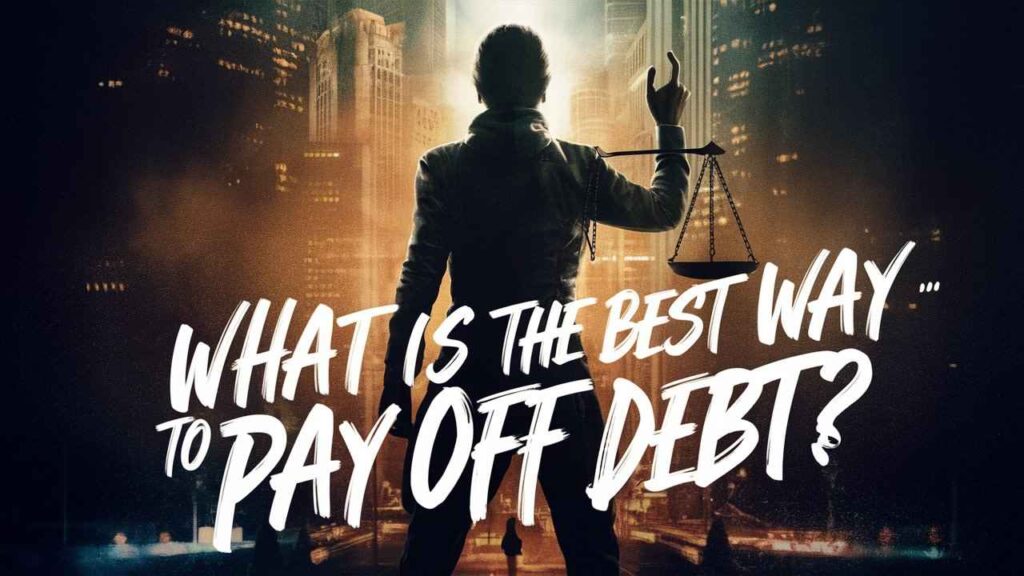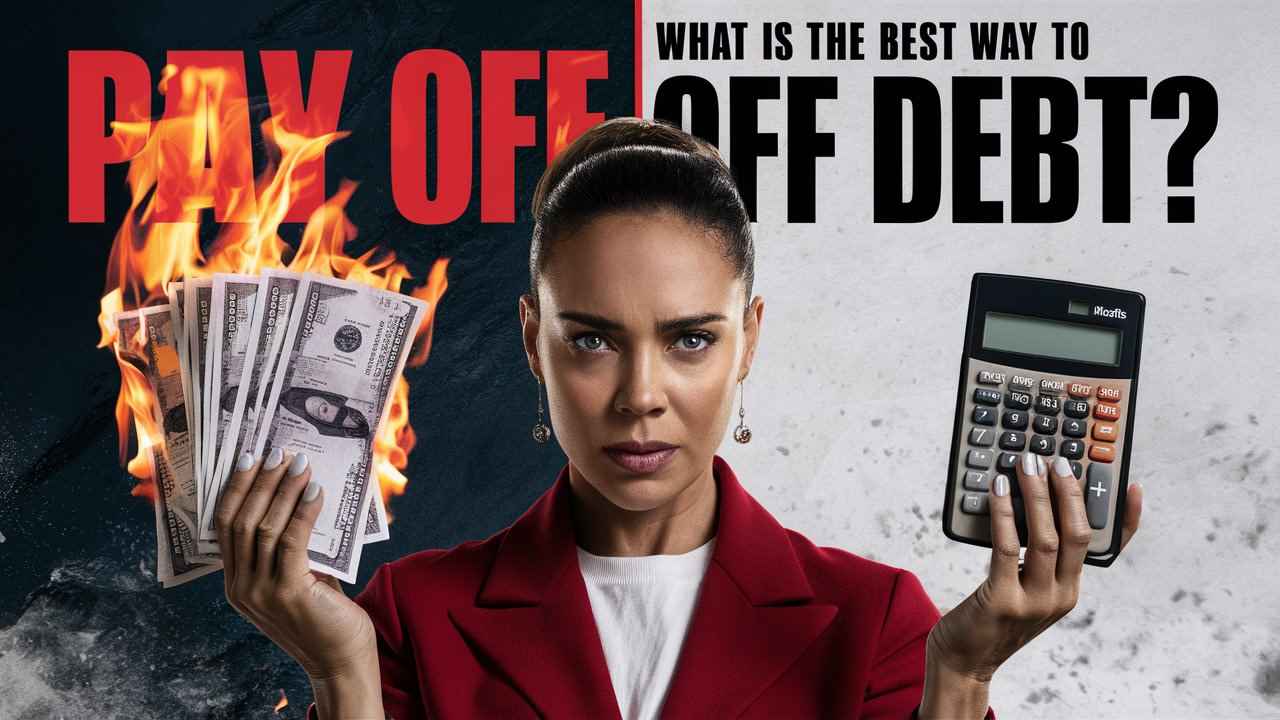Debt can feel like an insatiable monster, lurking in the shadows, ready to pounce whenever you least expect it. But fear not! With the right strategies and a sprinkle of determination, you can tame that beast and embark on a glorious journey toward financial freedom. Buckle up as we navigate the winding roads of debt repayment and discover the best ways to Pay Off Debt.

The Different Types of Debt: Good vs. Bad
Ah, debt💲it’s a bit like a double-edged sword. On one side, we have good debt, which can actually help you build wealth. Think of student loans for your higher education or a mortgage that buys you a cozy home. These are investments in your future, much like planting a tree that bears fruit.
On the flip side lies bad debt, the financial equivalent of a black hole. Credit cards with sky-high interest rates, personal loans for impulse buys, or any debt that drains your wallet without offering any returns💲these are the foes you must face head-on. Recognizing the difference between these two types is crucial in crafting your strategy to Pay Off Debts. After all, you wouldn’t battle a dragon with a butter knife, would you?
The Real Cost of Debt: Interest Rates and Fees
Let’s talk about the sneaky villain in the debt story: interest rates. They can transform a reasonable amount owed into a monstrous burden. Imagine borrowing $1,000 with an interest rate of 20%💲if you only make minimum payments, you could end up paying back nearly double! Those pesky fees and penalties can turn your best intentions into financial nightmares.
When assessing your debt, consider both the interest and any additional costs. Armed with this knowledge, you can prioritize which debts to tackle first, ensuring you strike where it hurts the most!

Getting Real: Assessing Your Debt Situation
How to Create a Comprehensive Debt List
Before you charge into battle, it’s essential to assess your battlefield. Start by creating a comprehensive list of all your debts. This should include the lender’s name, the total amount owed, interest rates, and minimum monthly payments.💲
You might find it helpful to use a spreadsheet or a debt-tracking app like Mint or YNAB (You Need A Budget) to keep everything organized. This exercise may feel daunting, but trust me, it’s liberating to see your debts laid out clearly. Think of it as pulling back the curtain on your financial situation.
Crunching the Numbers: Total Amount Owed and Monthly Payments
Now that you’ve got your list, it’s time to crunch the numbers. Calculate your total debt and monthly payments. This snapshot gives you a clear picture of your financial landscape.💲
If you’re feeling particularly adventurous, try calculating the time it will take to Pay Off Debt at your current payment rate. Spoiler alert: the number may not be as encouraging as you’d like! But don’t fret; it’s merely a starting point. Knowing where you stand allows you to make informed decisions moving forward.

Goal-Setting: The Fun Way to Conquer Your Debt
SMART Goals: Specific, Measurable, Achievable, Relevant, Time-Bound
Time to turn that overwhelming monster into a manageable pet! Set SMART goals for your debt repayment. Specific means you’ll pinpoint the exact amount you want to pay off. Measurable indicates that you can track your progress. Achievable ensures your goals are realistic (no wishing to pay off $100,000 in a month, okay?). Relevant ties into your larger financial picture, and Time-Bound gives you a deadline.
For example, “I want to Pay Off Debt by reducing my credit card balance by $500 over the next two months” is a SMART goal. The clearer you are, the easier it becomes to slay the dragon.💲
Creating a Debt Payoff Timeline That Keeps You Motivated
Next, create a timeline for your goals. Visualizing your progress can be a significant motivator. Use a calendar or a chart to mark milestones. Celebrate small victories💲maybe treating yourself to a movie night after paying off your first debt!
This timeline serves as both a guide and a source of motivation. The key here is to keep it flexible; life can throw curveballs, and that’s okay. What matters is your commitment to keep moving forward.

Budgeting Basics: Your Financial Playbook
The 50/30/20 Rule: A Simple Guide to Budgeting
Now that you’ve set your goals, let’s tackle budgeting! The 50/30/20 rule is a straightforward way to allocate your income:
- 50% for Needs: This includes rent, groceries, and utilities.
- 30% for Wants: This is your discretionary spending, such as dining out and entertainment.
- 20% for Savings and Debt Repayment: This is the golden nugget for Paying Off Debts.
By adhering to this rule, you can ensure that your finances are balanced and that you’re still enjoying life while making progress on your debt.
Cutting Costs: Where to Trim the Fat Without Feeling Deprived
Next, take a good hard look at your expenses. What can you cut? No, you don’t have to live like a hermit! Look for areas where you can trim the fat without sacrificing your sanity.
Consider canceling unused subscriptions or cutting back on that daily coffee run. Small changes can yield significant savings. Even diverting $5 a day can add up to $150 a month💲money that can go straight to your debt!

Choosing Your Battle Plan: Strategies to Pay Off Debt
The Snowball Method: Small Wins for Big Motivation
The Snowball Method is all about starting small. List your debts from smallest to largest, and focus on paying off the smallest one first while making minimum payments on the others.
Once you pay off the smallest debt, celebrate! Then, roll that payment into the next smallest debt. This method builds momentum and motivation. Who doesn’t like a victory dance?💲
The Avalanche Method: Slaying High-Interest Monsters First
Alternatively, consider the Avalanche Method. This strategy focuses on paying off debts with the highest interest rates first, which saves you money in the long run. While it may lack the instant gratification of the Snowball Method, the math is compelling💲less interest equals a quicker path to financial freedom.
Choose the method that resonates with you. After all, what works for one person might not work for another!
Balance Transfers: A Sneaky Way to Lower Interest Rates
If you’re carrying credit card debt, a balance transfer might be your knight in shining armor. By transferring your high-interest balances to a credit card with a lower interest rate (or a promotional 0% interest rate), you can save a pretty penny.
Just be sure to read the fine print. Balance transfers can come with fees, and promotional rates can expire, leaving you in a sticky situation if you aren’t careful.💲

Getting Creative: Side Hustles and Extra Income Streams
Fun and Quirky Side Hustles to Boost Your Paycheck
Looking for ways to ramp up your income? Embrace your inner entrepreneur! Side hustles don’t have to be tedious. Consider quirky options like pet sitting, becoming a mystery shopper, or even renting out your closet space on apps like Poshmark.
Let your creativity flow! Turn your skills into cash💲whether it’s baking the world’s best cookies or crafting artisanal soap. The extra income can be a game-changer when it comes to Paying Off Debts.
How to Turn Hobbies into Cash: Monetize Your Passion
Is there a hobby you adore? Why not turn it into a source of income? Whether it’s photography, graphic design, or even woodworking, there’s a market for your talents. Websites like Etsy and Fiverr allow you to showcase your skills to the world.
Transforming your passion into profit is not just a way to boost your earnings; it’s also an exhilarating adventure.
The Art of Negotiation: Reducing Your Debt Burden
How to Talk to Creditors: Tips for Negotiating Lower Rates
Let’s be honest💲creditors can be a tough crowd. But they’re also human, and negotiation is part of their business model. If you’re struggling with payments, pick up the phone and have a heart-to-heart.
Explain your situation. Many creditors are willing to work with you to find a solution, whether it’s lowering your interest rate or creating a more manageable payment plan. Don’t underestimate the power of a polite yet firm request!
Settling for Less: Is Debt Settlement Right for You?
Debt settlement can be a viable option if you’re struggling to make payments. It involves negotiating with creditors to pay a lump sum that’s less than the total owed. While this might sound appealing, it can impact your credit score.
Consider this path carefully, weighing the pros and cons. It may offer relief in the short term, but make sure you understand the long-term ramifications.💲
Staying Motivated: Keeping the Fire Burning
Celebrating Small Wins: Reward Yourself Without Breaking the Bank
As you make strides in Paying Off Debt, don’t forget to celebrate! Small wins deserve recognition. Treat yourself to a movie night, a fancy coffee, or a bubble bath.
These little rewards keep morale high and remind you that you’re on the right track. Just ensure that your celebrations don’t derail your budget.
Finding Accountability: Join a Group or Partner Up!
Sometimes, all you need is a little camaraderie. Find a friend or family member to join you on your debt-repayment journey. You can share strategies, hold each other accountable, and even celebrate successes together.Consider joining a group or forum online, such as those on Reddit or Facebook. Sharing experiences and tips can provide the motivation you need to keep pushing forward.
Using Technology: Apps to Make Debt Payoff Easier
The Best Budgeting Apps for Tracking Your Progress
In this tech-savvy age, there’s no shortage of apps designed to help you manage your finances. Use budgeting apps like Mint, YNAB, or PocketGuard to track your spending and set savings goals.
These tools make it easy to visualize your progress, which can be incredibly motivating. Plus, many apps offer insights into your spending habits, helping you find areas for improvement.
Debt Snowball Calculators: Visualize Your Victory!
Want a visual representation of your journey? Debt snowball calculators are a fun and helpful way to see your progress. These calculators can help you plot out your repayment strategy, showing you how long it will take to achieve debt freedom. Watch those numbers shrink and your motivation grow!
Avoiding Pitfalls: What Not to Do When Paying Off Debt
Common Mistakes That Can Derail Your Efforts
On your quest to Pay Off Debt, watch out for common pitfalls. Ignoring your budget, racking up new debt, or underestimating your expenses can send you spiraling.
Stay vigilant. Regularly review your progress, adapt your strategies as needed, and remain committed to your goals. A little foresight can save you from big headaches down the line.
The Temptation of New Debt: Avoiding the Credit Card Trap
Credit cards can be both friend and foe. While they offer convenience, they can also lead to dangerous habits if you aren’t careful. The temptation to swipe for that shiny new gadget or last-minute vacation can be hard to resist.💲
Keep your eye on the prize. Focus on your debt repayment goals, and resist the siren call of new debt until you’ve conquered the existing monsters.
Long-Term Financial Health: Staying Debt-Free
Building an Emergency Fund: Your Safety Net for the Future
Once you’ve successfully navigated your debt repayment journey, it’s time to focus on building an emergency fund. This financial cushion will protect you from unforeseen expenses💲like car repairs or medical bills💲ensuring you don’t fall back into the debt trap.
Aim for at least three to six months’ worth of expenses in your emergency fund. This way, you can face life’s surprises with confidence.
Investing 101: Grow Your Wealth After Debt Freedom
Now that you’re debt-free, consider investing! It’s time to make your money work for you. Whether you opt for stocks, bonds, or real estate, educating yourself on investing will pay off in the long run.
Start small, and gradually increase your investments as you become more comfortable. With patience and perseverance, you can watch your wealth grow, creating a future filled with possibilities.💲
Conclusion: Celebrating Your Journey to Debt Freedom
Reflecting on Your Progress: From Debt to Financial Independence
Take a moment to pause and reflect on how far you’ve come. From battling the debt monster to achieving financial independence, your journey is an inspiration. Each step, no matter how small, has contributed to your success. Celebrate this victory and share your story with others. You never know who you might inspire to take control of their financial destiny!💲
Final Tips for Maintaining a Healthy Financial Future
As you embark on this new chapter, remember these final tips:
- Keep tracking your spending. Awareness is key.
- Continue to build your emergency fund.
- Stay informed about personal finance.
- Don’t shy away from seeking help when needed.
With a solid plan and unwavering determination, you can maintain your financial health and keep that debt monster at bay. Go forth, and may your journey to Pay Off Debt be filled with triumph!
People Also Ask
What does it mean to pay down debt?
Paying down debt refers to the process of reducing the total amount owed to creditors. This can be achieved by making regular payments that are applied to the principal balance of the debt. The goal is to gradually decrease the outstanding balance until it is fully paid off, ultimately leading to financial freedom.
What is a word for paying off debt?
A common word for paying off debt is “repayment.” This term encompasses the act of settling your outstanding obligations to lenders, whether through regular installments or lump-sum payments.
How to pay off $50,000 in debt in 1 year?
To pay off $50,000 in debt within a year, you need to adopt a robust repayment strategy. Start by assessing your monthly income and expenses to determine how much you can allocate towards debt repayment. Consider using the Avalanche Method to focus on high-interest debts first. Aim to pay approximately $4,167 per month. This might involve cutting unnecessary expenses, increasing your income through side hustles, or negotiating lower interest rates with creditors.
Is it smart to pay off debt?
Yes, it is generally smart to pay off debt, especially high-interest debts. Reducing debt alleviates financial stress, improves credit scores, and enhances overall financial stability. It frees up funds for savings and investments, leading to better long-term financial health.
How to pay off $5,000 in debt in 6 months?
To pay off $5,000 in debt in 6 months, you would need to pay about $833 each month. Start by creating a budget to identify where you can cut back on expenses. Consider side jobs or freelance work to increase your income. Using the Snowball Method, you can also prioritize paying off the smallest debts first to build momentum and motivation.
How to clear off debt?
Clearing off debt involves a systematic approach to repayment. Start by listing all your debts, including amounts, interest rates, and payment terms. Choose a repayment strategy that suits you—like the Snowball or Avalanche method. Stick to a budget, cut unnecessary expenses, and consider increasing your income.
Is it good to pay off bad debt?
Yes, paying off bad debt is generally a good idea. Bad debt, such as high-interest credit cards, can quickly spiral out of control and lead to financial distress. Reducing or eliminating this type of debt not only improves your financial situation but also relieves stress.
What is a good debt?
Good debt refers to borrowed money that is considered an investment in your future, such as student loans for education or a mortgage for a home. These debts typically have lower interest rates and can potentially lead to increased income or asset value over time.
What do I do if I’m in debt and have no money?
If you’re in debt and have no money, it’s crucial to reassess your budget. Look for ways to cut expenses drastically, consider negotiating with creditors for lower payments, or seek financial assistance. You might also explore community resources or non-profit credit counseling services to help manage your debt.
How is debt paid off?
Debt is paid off through a combination of making regular payments, whether in installments or as lump sums. Each payment reduces the principal amount owed and, depending on the terms, may also cover interest. As debts are reduced, your financial obligations decrease, ultimately leading to debt freedom.
Which debt to pay first?
When deciding which debt to pay first, consider using either the Snowball Method (paying off the smallest debts first for psychological wins) or the Avalanche Method (tackling the highest interest debts first to save money). Prioritizing high-interest debts usually saves you the most in interest payments.
Why is it hard to pay off debt?
Paying off debt can be challenging due to high interest rates, unexpected expenses, and lifestyle inflation. Additionally, emotional spending habits or a lack of a clear repayment plan can make it difficult to maintain consistent payments. It requires discipline, budgeting skills, and often a change in mindset.
How to make money to pay off debt?
To make money to pay off debt, consider starting a side hustle or freelance work that aligns with your skills. Sell unwanted items, take on part-time work, or offer services such as tutoring or pet sitting. The extra income can be directly allocated towards your debt repayments.
What happens if you pay off all your debt?
If you pay off all your debt, you’ll experience a significant boost in your financial freedom. It often leads to an improved credit score, increased savings potential, and reduced financial stress. However, it’s essential to maintain a budget and build an emergency fund to avoid falling back into debt.
How to pay $30,000 debt in one year?
To pay off $30,000 in one year, you need to allocate approximately $2,500 per month. This can be achieved through strict budgeting, reducing expenses, and possibly increasing your income. Employ strategies like the Snowball Method or Avalanche Method to stay motivated and focus your efforts effectively.
Does paying off debt feel good?
Yes, paying off debt can feel incredibly liberating. It often brings a sense of accomplishment and relief, as you are freeing yourself from financial burdens. The emotional weight lifted can lead to increased confidence and a renewed focus on building wealth.
Why pay off debt before investing?
Paying off debt before investing is often advised because high-interest debts can erode potential investment returns. By eliminating these debts first, you free up more money to invest in assets that appreciate over time, ultimately leading to better long-term financial health.
What not to do when paying off debt?
When paying off debt, avoid ignoring your budget, accumulating more debt, or making only minimum payments. Additionally, don’t neglect to celebrate small victories or overlook the importance of maintaining an emergency fund while repaying debt.
What is it called to pay off debt?
The act of paying off debt is commonly referred to as “debt repayment” or “debt settlement,” depending on the context. Repayment involves consistently making payments until the debt is fully settled.
What does it mean to pay off debt?
To pay off debt means to fulfill your obligation to creditors by repaying the borrowed amount, typically with interest, until the debt is fully cleared.
What is a debt off?
“Debt off” is not a commonly used term in financial discussions, but it could refer to the action of eliminating or paying off debt. The phrase implies successfully managing financial obligations to achieve a debt-free status.











